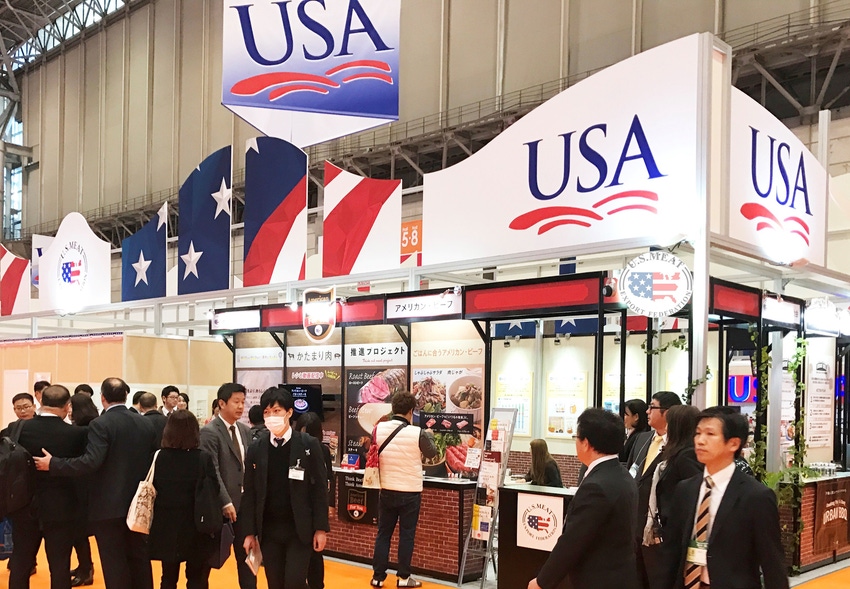The average import value paid by Japan last year for U.S. beef tongues was $6.82 per pound – a tremendous premium over the domestic market or any other international destination. And that increases the value of U.S. cattle across the board.
April 13, 2017

Remember the last time you ate beef tongue? That might be a hard question to answer, because beef tongue just isn’t at the top of the shopping list for most U.S. consumers.
But it’s a delicacy in Japan. So U.S. beef tongue was recently a featured attraction at FoodEx 2017 in Tokyo. FoodEx is Asia’s largest food trade show, attracting more than 75,000 buyers over four days. With support from the beef checkoff program and the USDA Market Access Program, the U.S. Meat Export Federation (USMEF) demonstrated a new concept at FoodEx – sous-vide style beef tongue. Sous-vide is a method of cooking the product at a lower temperature in a vacuum-sealed pouch.
“Our goal was to demonstrate the flavor and tenderness of U.S. beef tongue because many Japanese restaurants and foodservice companies serve it,” said Greg Hanes, USMEF assistant vice president for international marketing. “They are always looking for new and better ways to appeal to their customers and sous-vide style was a new and unique concept to them. The samples backed up what we have been telling buyers about the quality of U.S. beef tongue.”
The impact of Japanese demand on U.S. beef tongue was never more apparent than when tongues struggled to find value during the BSE-related closure of the Japanese market. After a partial market reopening in 2005, Japan’s 20-month cattle age limit on U.S. beef – which remained in place until February 2013 – still hindered tongue exports because a large percentage of U.S. beef tongues were still ineligible.
By 2011, Japan’s imports of U.S. tongue had reached about 6,500 metric tons (mt), accounting for 30% of its total tongue imports. But in 2013, with Japan raising its cattle age limit on U.S. beef imports to 30 months, Japan’s imports of U.S. beef tongue jumped dramatically – more than doubling to 16,588 mt and capturing 50% of Japan’s imported beef tongue market.
Japan is now again the dominant market for U.S. beef tongue. In 2016, imports climbed to 19,049 mt, up 15% year-over-year, while value increased 43% to $286 million. With Japanese buyers placing great emphasis on quality, more than half of Japan’s tongue imports from the United States are chilled, rather than frozen. In fact, the U.S. dominates Japan’s chilled tongue imports, holding 73% market share.
Prior to U.S. beef gaining expanded access to Japan in 2013, Mexico and Russia were also big customers for beef tongue, but Japan has now bid the product away from the rest of the world. The average import value paid by Japan last year was $6.82 per pound – a tremendous premium over the domestic market or any other international destination. By comparison, export value for U.S. frozen tongues in 2012, prior to expanded access in Japan, averaged $2.73 per pound.
“The post-2012 shift in tongue exports illustrates an important principal for maximizing carcass value – getting each item to the market that values it most,” said USMEF Economist Erin Borror. “Japan is the dominant destination for U.S. tongues, and this isn’t likely to change. There is demand in markets such as Mexico, Egypt and Hong Kong, but buyers there just can’t compete with the prices U.S. tongues command in Japan.”
For this reason, USMEF continues to seek new buyers and explore expanded opportunities with existing customers within the Japanese market – which was the main objective of the sous-vide demonstration at FoodEx.
“We had a very active show at FoodEx, interacting with both current and potential customers, and seeing what our competition is doing as well,” said Hanes. “The mix of attendees was amazing. It ranged from representatives of small importers and restaurant chains all the way to top executives from some of the largest food companies in Japan.”
Schuele is vice president, communications, with the U.S. Meat Export Federation in Denver, Colo.
About the Author(s)
You May Also Like



